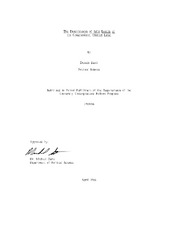| dc.contributor.advisor | Gant, Michael | |
| dc.creator | Black, Dennis | |
| dc.date.accessioned | 2022-04-01T16:00:01Z | |
| dc.date.available | 2022-04-01T16:00:01Z | |
| dc.date.issued | 1986 | |
| dc.identifier.uri | https://hdl.handle.net/1969.1/CAPSTONE-DodgeM_1998 | |
| dc.description | Program year: 1985/1986 | en |
| dc.description | Digitized from print original stored in HDR | en |
| dc.description.abstract | Previous research on split-ticket voting has concentrated on the level or cause of split-ticket voting. There are many methodological problems with this approach. Thus, this paper studies the determinants of split results instead. The paper argues that split results are mainly a result of the conflict between competing forces -- incumbency and partisanship. An analysis of the elections of 1972, 1976. and 1980 for all 435 Congressional districts confirms this hypothesis. Consequently, they should continue to be an important factor in American politics suggesting that continued governmental policy stalemate between the legislative and executive branch is a possibility. | en |
| dc.format.extent | 43 pages | en |
| dc.format.medium | electronic | en |
| dc.format.mimetype | application/pdf | |
| dc.subject | split-ticket voting | en |
| dc.subject | split results | en |
| dc.subject | incumbency | en |
| dc.subject | partisanship | en |
| dc.subject | Congressional districts | en |
| dc.subject | 1972 election | en |
| dc.subject | 1976 election | en |
| dc.subject | 1980 election | en |
| dc.subject | governmental policy stalemate | en |
| dc.title | The Determinants of Split Results at the Congressional District Level | en |
| dc.type | Thesis | en |
| thesis.degree.department | Political Science | en |
| thesis.degree.grantor | University Undergraduate Fellow | en |
| thesis.degree.level | Undergraduate | en |
| dc.type.material | text | en |


